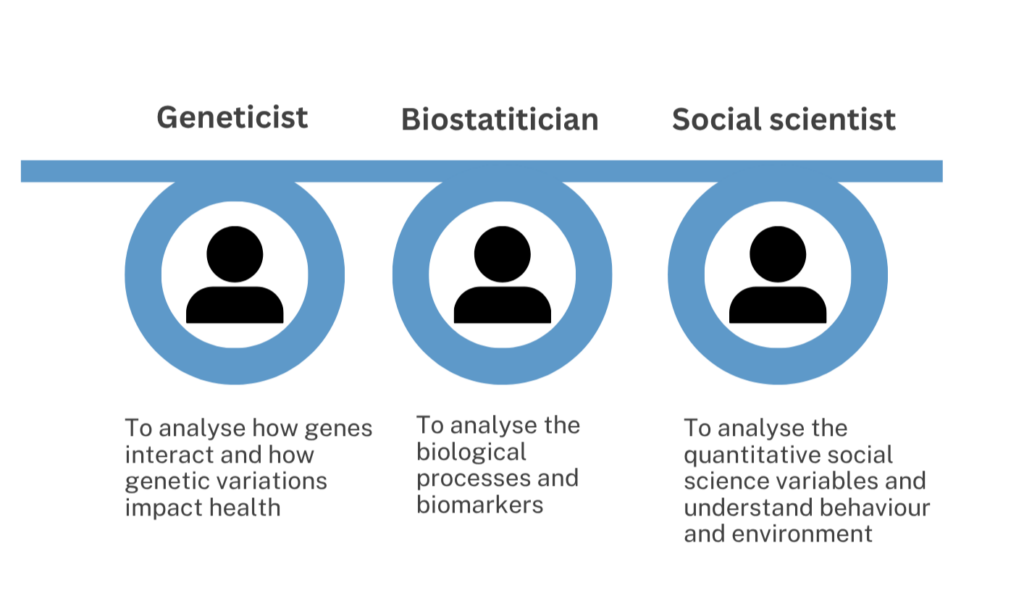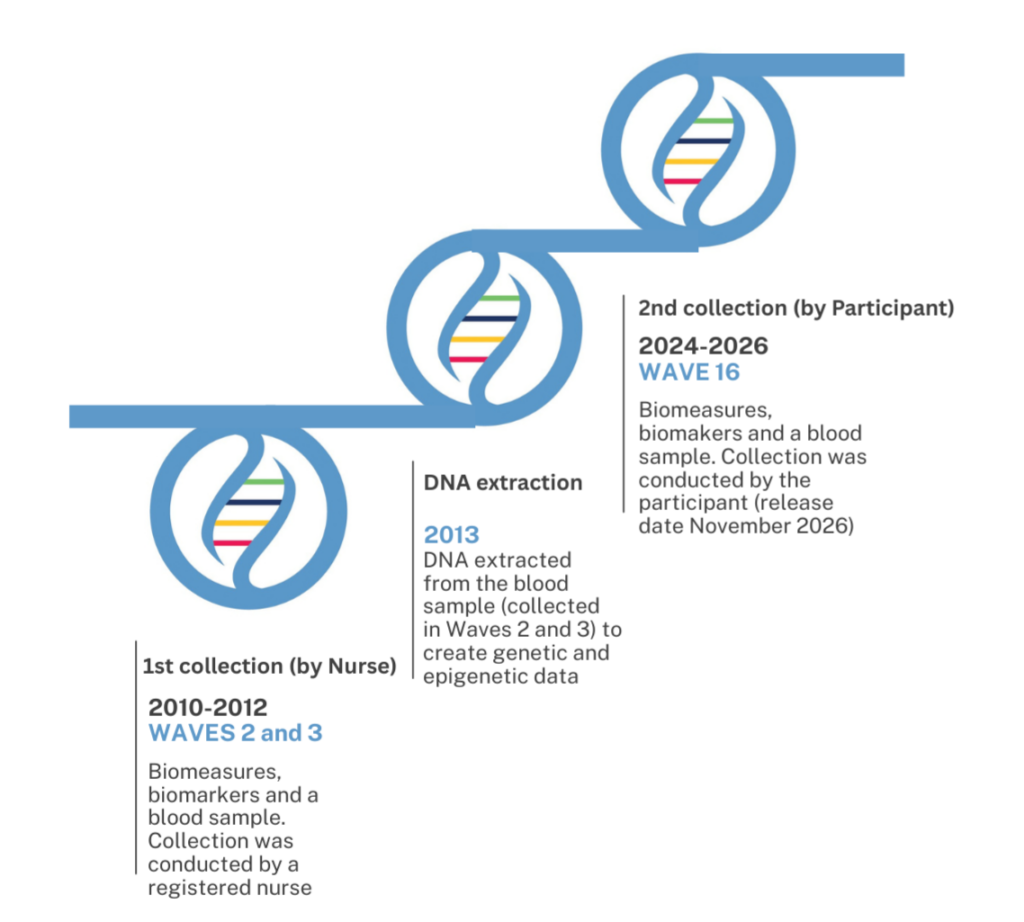Understanding Society is the largest longitudinal study of its kind and covers a wide range of topics including health. This page outlines the pathway for users to explore our different types of health datasets and how to apply to use them.
DISCOVER
1
Overview
The Data Releases page lists the latest Wave of data available for our Main Study as well as the other health, biomarker, genetics and epigenetics datasets we produce (these are explained below in section 3). Some of these datasets are available under Special Licence agreements and are explained on our Access the Understanding Society data web page.
Why use our health data?
Health researchers can benefit from using Understanding Society for several reasons including the:
- Longitudinal aspect of the data
- Repeated measures used
- Representative population
Each year Understanding Society asks question about general health. In some Waves physical measures are also collected, including biomeasures, biomarkers and blood samples. These were first collected in 2010-2012 with DNA extracted from the blood sample to produce genetic and epigenetic data, also known as Omics data. New biomeasures, biomarkers and blood samples have been collected again in Wave 16 (due for release in November 2026).
Accessing the data
Understanding Society data are available through the UK Data Service, however researchers wanting to use the Omics genetics and epigenetics data in combination with the Understanding Society Main Survey data need to apply to Understanding Society. Combining the data in this way allows researchers to explore the long term impacts of environmental factors on individuals. See sections 6 and 7 below for further details.
2
Types of health data
What type of health data are you looking to use in your research?
- Physical health data – biomeasures, e.g. blood pressure, hip waist measurement, weight, height, body fat, grip strength, lung function and medications
- Biomarker measures – lipids (cholesterol, testosterone, triglycerides and so on taken from the blood sample
- Omics data – DNA extracted from the blood sample to create genetics and epigenetics data
- Main survey data, social and econimic data, e.g. self-reported health conditions, financial situation (see all the topics covered by the Main survey)
Using variables from the Main survey combined with Omics data, under Special Licence, means you can explore how environmental factors can affect individuals’ health.
3
Our datasets
| Dataset | Description | How to use the data | Skills needed |
|---|---|---|---|
| Main survey and data files | The largest longitudinal household panel study of its kind collects data from over 40,000 participants about how their lives change and remain the same. Data have been collected for over a decade and if combined with its predecessor the British Household Panel Study span over 30 years. | Explore the topic health and wellbeing and investigate people’s health within and across families over time and place (see the other topics included in the Study) Combine variables from the Main survey with the Omics genetic/epigenetic data under special licence to examine how environmental factors can affect individuals (see below). | Social science Social science and Life science |
| Nurse Health Assessment (physical health) | Participants are asked about their general health in the Main survey. Waves 2 and 3 (2010-2012) contain a follow-up Nurse health assessment which collected a range of bio-medical measures and blood samples available in the Nurse Health Assessment dataset. Wave 16 (2024-2026) contains more biomeasures, bio-markers and blood samples collected this time by participants. | Explore the anthropometric measurements, which include: height, weight, waist circumference, percentage of body fat; blood pressure, lung function, grip strength, and a number of derived variables for prescription medications. The biomarkers include lipids, liver and kidney function, markers for anaemia, diabetes, and inflammation as well as a number of hormones that provide information about ageing. | Social science and Life science |
| Proteomic panels | Proteomics is the analysis of a large set of protein molecules. Data from Understanding Society has been used to create two proteomic panels: one for proteins from the cardiometabolic panel (heart and blood vessels and metabolic health, for example diabetes) and one for proteins in the neurology panel (brain development and neurodegenerative disease. | When biomarkers have been measured in social science surveys, they can be used to study the social patterning of disease risk and wellbeing; for example, biomarkers of inflammation and haemostasis have been associated with educational attainment. | Life science |
| Epigenetic Ageing algorithms (Epigenetic clocks) | Measures of “biological ageing” derived from DNA methylation analyses of DNA extracted from blood samples taken at Wave 2 and 3 of the Main Survey | Explore whether a person’s “biological age” is correlated with social factors, for example differences between actual age and biological age may be related to life circumstances and environment. | Life science |
| Polygenetic risk scores | Continuous variable that reflects an individual’s genetic predisposition towards a given trait. These traits can include disease status, behaviours, and blood levels of biomolecules, among many others. The scores are available in the Special Licence version of the Nurse Assessment dataset (SN 7587) | Explore whether genetic predispositions to particular traits affects an individual’s health and well being, such as the relationship between personality traits, lifestyle and life satisfaction. | Life science |
| Genetics combined with the Main Survey | Genotypes from genome-wide scan (Illumina human core exome array) conducted on DNA samples from approximately 10,000 people of European ancestry, collected from participants at Waves 2 and 3 | Investigate the genetic background behind social and economic factors over a lifetime, or use genetic variants or scores as proxies to investigate relationships between genetic predispositions to an exposure of interest and social and economic factors influencing their environment. | Life science and Social Science |
| Epigenetics combined with the Main Survey | Methylation profiling carried out on DNA samples collected from approximately 3650 participants at Waves 2 and 3 | DNA methylation markers (or scores derived by combining individual markers) can be used to explore how social factors over a lifetime might affect biological processes, altering how genes work. | Life science and Social Science |
4
5
Variable search
The Variable Search helps you find variables needed for your research in the Main Survey. The Variable Search can be used in multiple ways to search by variable name or keyword, by data files, by thematic index terms, or by questions or question modules. Each variable includes a frequency for each wave in which it appears. Some variables also have notes with more information about the variable.
- Find variables from the Main survey containing general health questions
- Find nurse collected biomeasures and biomarker variables collected in Waves 2 and 3 (released under the Nurse Health Assessment dataset). Biomeasures and biomarker variables collected in Wave 16 will be added in November 2026.
6
Building your research team to use Omics data
Depending on your research questions it can be important to have a research team who can work with both social science data and life science data. We advice having a biostatistician/geneticist to help analyse the Omics data.

- If you are social scientist get in touch for an introduction to bio researchers
7
Applying to use Omics data
Omics data can be combined with variables from the Main survey as part of an approved Omics project to explore the long term impacts of environmental factors on individuals.
Find out how to apply for Omics data combined with Understanding Society survey data, including:
- Who can apply and from which countries
- How to register and access the Omics portal to submit your project
- How to select Main Survey variables to add to the project
- Which files to submit with your application
- Timeline for application
LEARN
8
Training videos
We provide training material on our website:
- Watch Professor Michaela Benzeval talk about integrating biological and social data for research and how to use biological data in social science research
- Watch our training video on Multi-omic data analysis methods in biosocial research
- Listen to our Biomarkers and genetic data podcast
We will provide training for the new biomarker and Omics data being collected in Wave 16 on our Training page.
9
Latest research – how have people used the data?
- See how the data was used to explore a wide range of health research questions in Approved Omics projects
- Visit the publications library to find research publications using the Omics data
SUPPORT
10
User Support Forum
If you have a query and want to discuss it directly with our User Support team there are different ways to get in touch.
Our User Support Forum is a dedicated service for our users where you can search for questions which have been asked before. If your question hasn’t already been answered, you can post it on our User Forum. You just need to click on the link in the top right-hand corner to register.
You can also email the User Support team to ask a question or request an Online helpdesk session. Search the User Forum to see if your question has been asked; if you post a question other users can benefit from the answer provided.
Need help applying for Omics projects?
If you need help applying for an Omics project, data enquiries should be sent to genetics@understandingsociety.ac.uk. If you have already applied for the Omics data, please post your question in your application/project in the omics portal.
Receive the latest updates
- See the latest data releases and those which are planned
- Sign-up to our Newsletter for news and events
